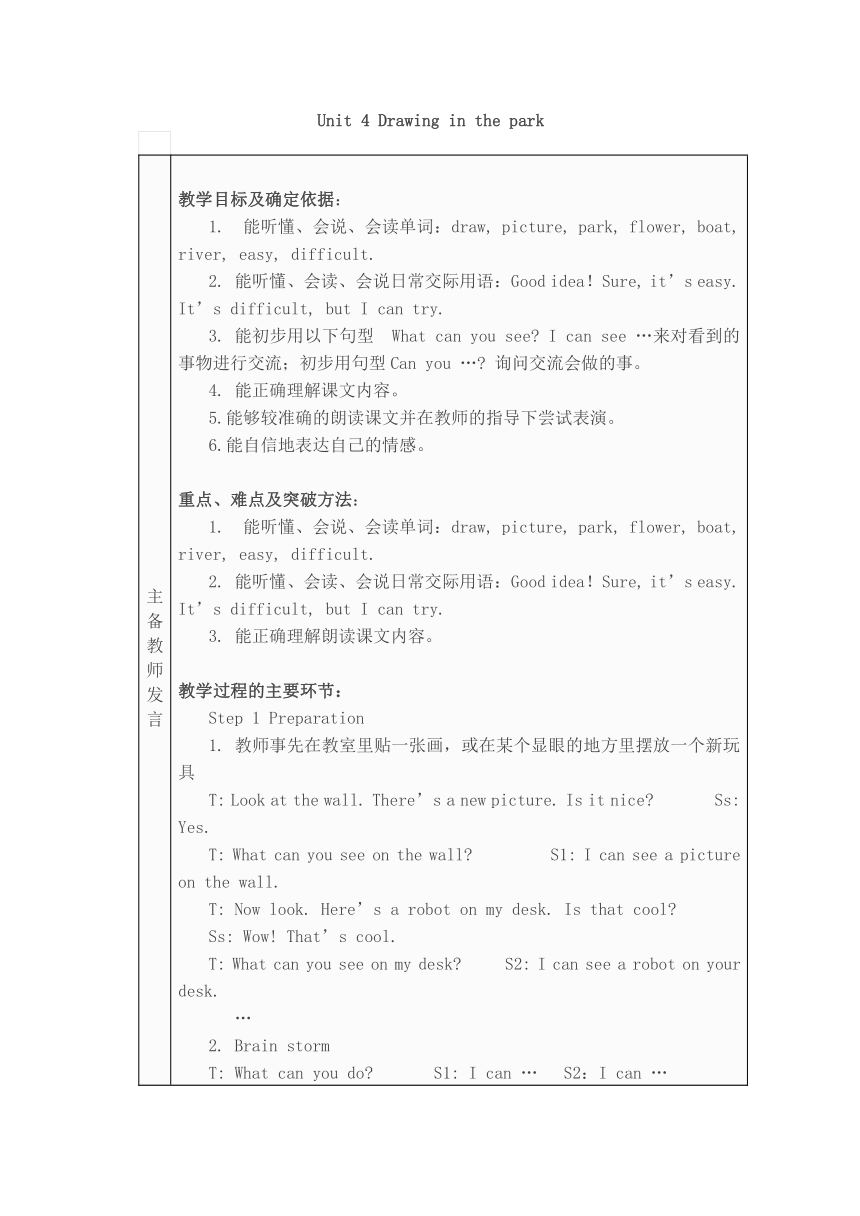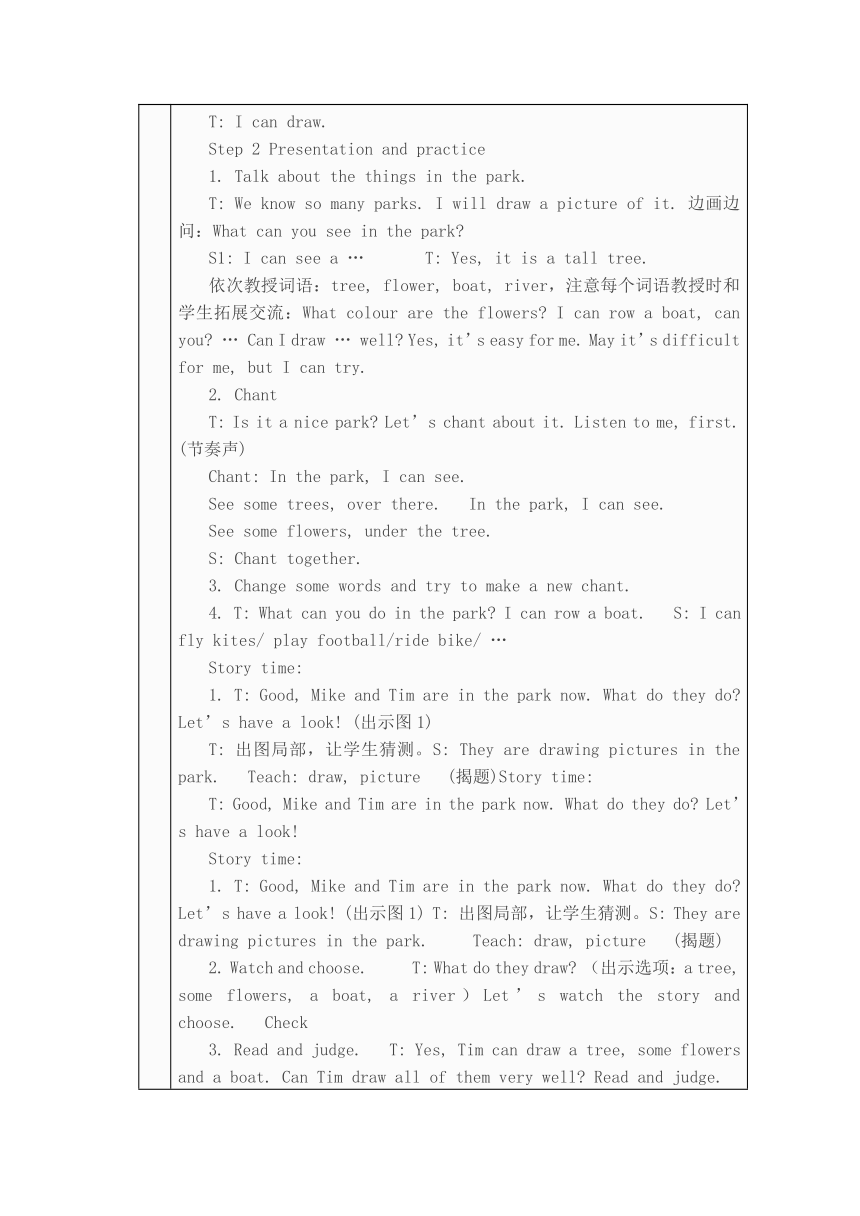Unit 4 Drawing in the park表格式教案
文档属性
| 名称 | Unit 4 Drawing in the park表格式教案 |  | |
| 格式 | docx | ||
| 文件大小 | 20.1KB | ||
| 资源类型 | 教案 | ||
| 版本资源 | 牛津译林版 | ||
| 科目 | 英语 | ||
| 更新时间 | 2024-07-06 17:27:57 | ||
图片预览


文档简介
Unit 4 Drawing in the park
主备教师发言 教学目标及确定依据: 1. 能听懂、会说、会读单词:draw, picture, park, flower, boat, river, easy, difficult. 2. 能听懂、会读、会说日常交际用语:Good idea!Sure, it’s easy. It’s difficult, but I can try. 3. 能初步用以下句型 What can you see I can see …来对看到的事物进行交流;初步用句型Can you … 询问交流会做的事。 4. 能正确理解课文内容。 5.能够较准确的朗读课文并在教师的指导下尝试表演。 6.能自信地表达自己的情感。 重点、难点及突破方法: 1. 能听懂、会说、会读单词:draw, picture, park, flower, boat, river, easy, difficult. 2. 能听懂、会读、会说日常交际用语:Good idea!Sure, it’s easy. It’s difficult, but I can try. 3. 能正确理解朗读课文内容。 教学过程的主要环节: Step 1 Preparation 1. 教师事先在教室里贴一张画,或在某个显眼的地方里摆放一个新玩具 T: Look at the wall. There’s a new picture. Is it nice Ss: Yes. T: What can you see on the wall S1: I can see a picture on the wall. T: Now look. Here’s a robot on my desk. Is that cool Ss: Wow! That’s cool. T: What can you see on my desk S2: I can see a robot on your desk. … 2. Brain storm T: What can you do S1: I can … S2:I can … T: I can draw. Step 2 Presentation and practice 1. Talk about the things in the park. T: We know so many parks. I will draw a picture of it. 边画边问:What can you see in the park S1: I can see a … T: Yes, it is a tall tree. 依次教授词语:tree, flower, boat, river,注意每个词语教授时和学生拓展交流:What colour are the flowers I can row a boat, can you … Can I draw … well Yes, it’s easy for me. May it’s difficult for me, but I can try. 2. Chant T: Is it a nice park Let’s chant about it. Listen to me, first. (节奏声) Chant: In the park, I can see. See some trees, over there. In the park, I can see. See some flowers, under the tree. S: Chant together. 3. Change some words and try to make a new chant. 4. T: What can you do in the park I can row a boat. S: I can fly kites/ play football/ride bike/ … Story time: 1. T: Good, Mike and Tim are in the park now. What do they do Let’s have a look! (出示图1) T: 出图局部,让学生猜测。S: They are drawing pictures in the park. Teach: draw, picture (揭题)Story time: T: Good, Mike and Tim are in the park now. What do they do Let’s have a look! Story time: 1. T: Good, Mike and Tim are in the park now. What do they do Let’s have a look! (出示图1) T: 出图局部,让学生猜测。S: They are drawing pictures in the park. Teach: draw, picture (揭题) 2. Watch and choose. T: What do they draw (出示选项:a tree, some flowers, a boat, a river)Let’s watch the story and choose. Check 3. Read and judge. T: Yes, Tim can draw a tree, some flowers and a boat. Can Tim draw all of them very well Read and judge. 3. Read and judge. T: Yes, Tim can draw a tree, some flowers and a boat. Can Tim draw all of them very well Read and judge. Tips: 快速浏览故事并判断。(学生自己在书上画一画,如果Tim 能画得好则画星,画得不好画三角。) T: Tim can draw the tree and flowers very well, so they’re easy for Tim. Teach: easy So Tim says: Sure. It’s easy. 出示图2. T: 引导学生有感情地朗读该句话。Can you read it What else can you say S: So easy! It’s easy for me. T: But he can’t draw the boat, so it’s not easy, it’s difficult for him. Teach: difficult T: So Tim says: It’s difficult, but I can try. 出示图4. T: 引导学生有感情地朗读该句话。 5. T: You read very well. Listen and repeat 6. Read in pairs 7. Read the story together Step 3 Production Act the story ★Read fluently 流利的朗读 ★★Read fluently and beautifully 流利、有感情地朗读 ★★★Act it out emotionally 有感情地表演 Step 4 Progress 1. Make a new dialogue. 你和朋友也来到了一个美丽的公园。你们看到些什么?试着模仿今天学的故事,编一段对话吧。 课件出示一幅公园图片,有秋千、滑梯、放风筝、骑自行车等。以及参考句型: What can you see I can see …Can you draw / ride/ fly a … Yes, it’s easy. It’s difficult, but I can try. 2. Summary T: Today, we go to the park. Do you like the park From the learning of this lesson, what can you do now 引导学生用I can …总结今天的学习。 S: I can say/ read/ chant/ … Unit 4 Drawing in the park What can you see over there I can see a tree/ flowers/ a boat. easy —反— difficult 教学反思:本单元的主要学习内容是用I can see..的句型描述公园里的事物。教学中,我利用图片、幻灯片以及电脑课件引导学生观察和理解所学的语言。多媒体借助完成以后,大多数学生对于所学的概念有了一定程度的理解,但是还不够深刻。所以我又利用简笔画的形式,补充的降本单元出现的几个名词对应的简笔画呈现在黑板上,帮助学生加深理解。同时,可以借助黑板上的简笔画,对于生说Can you draw… 自然的引出本课的重点句型。通过对花的单数的描述,以及树的复数的描述,让学生体会代词it和them之间的区别。但是在教学中也存在一定的问题,学生对于draw easy difficult的发音理解和朗读起来有一点的困难。仍然需要结合以后的内容在课堂上加强训练。
主备教师发言 教学目标及确定依据: 1. 能听懂、会说、会读单词:draw, picture, park, flower, boat, river, easy, difficult. 2. 能听懂、会读、会说日常交际用语:Good idea!Sure, it’s easy. It’s difficult, but I can try. 3. 能初步用以下句型 What can you see I can see …来对看到的事物进行交流;初步用句型Can you … 询问交流会做的事。 4. 能正确理解课文内容。 5.能够较准确的朗读课文并在教师的指导下尝试表演。 6.能自信地表达自己的情感。 重点、难点及突破方法: 1. 能听懂、会说、会读单词:draw, picture, park, flower, boat, river, easy, difficult. 2. 能听懂、会读、会说日常交际用语:Good idea!Sure, it’s easy. It’s difficult, but I can try. 3. 能正确理解朗读课文内容。 教学过程的主要环节: Step 1 Preparation 1. 教师事先在教室里贴一张画,或在某个显眼的地方里摆放一个新玩具 T: Look at the wall. There’s a new picture. Is it nice Ss: Yes. T: What can you see on the wall S1: I can see a picture on the wall. T: Now look. Here’s a robot on my desk. Is that cool Ss: Wow! That’s cool. T: What can you see on my desk S2: I can see a robot on your desk. … 2. Brain storm T: What can you do S1: I can … S2:I can … T: I can draw. Step 2 Presentation and practice 1. Talk about the things in the park. T: We know so many parks. I will draw a picture of it. 边画边问:What can you see in the park S1: I can see a … T: Yes, it is a tall tree. 依次教授词语:tree, flower, boat, river,注意每个词语教授时和学生拓展交流:What colour are the flowers I can row a boat, can you … Can I draw … well Yes, it’s easy for me. May it’s difficult for me, but I can try. 2. Chant T: Is it a nice park Let’s chant about it. Listen to me, first. (节奏声) Chant: In the park, I can see. See some trees, over there. In the park, I can see. See some flowers, under the tree. S: Chant together. 3. Change some words and try to make a new chant. 4. T: What can you do in the park I can row a boat. S: I can fly kites/ play football/ride bike/ … Story time: 1. T: Good, Mike and Tim are in the park now. What do they do Let’s have a look! (出示图1) T: 出图局部,让学生猜测。S: They are drawing pictures in the park. Teach: draw, picture (揭题)Story time: T: Good, Mike and Tim are in the park now. What do they do Let’s have a look! Story time: 1. T: Good, Mike and Tim are in the park now. What do they do Let’s have a look! (出示图1) T: 出图局部,让学生猜测。S: They are drawing pictures in the park. Teach: draw, picture (揭题) 2. Watch and choose. T: What do they draw (出示选项:a tree, some flowers, a boat, a river)Let’s watch the story and choose. Check 3. Read and judge. T: Yes, Tim can draw a tree, some flowers and a boat. Can Tim draw all of them very well Read and judge. 3. Read and judge. T: Yes, Tim can draw a tree, some flowers and a boat. Can Tim draw all of them very well Read and judge. Tips: 快速浏览故事并判断。(学生自己在书上画一画,如果Tim 能画得好则画星,画得不好画三角。) T: Tim can draw the tree and flowers very well, so they’re easy for Tim. Teach: easy So Tim says: Sure. It’s easy. 出示图2. T: 引导学生有感情地朗读该句话。Can you read it What else can you say S: So easy! It’s easy for me. T: But he can’t draw the boat, so it’s not easy, it’s difficult for him. Teach: difficult T: So Tim says: It’s difficult, but I can try. 出示图4. T: 引导学生有感情地朗读该句话。 5. T: You read very well. Listen and repeat 6. Read in pairs 7. Read the story together Step 3 Production Act the story ★Read fluently 流利的朗读 ★★Read fluently and beautifully 流利、有感情地朗读 ★★★Act it out emotionally 有感情地表演 Step 4 Progress 1. Make a new dialogue. 你和朋友也来到了一个美丽的公园。你们看到些什么?试着模仿今天学的故事,编一段对话吧。 课件出示一幅公园图片,有秋千、滑梯、放风筝、骑自行车等。以及参考句型: What can you see I can see …Can you draw / ride/ fly a … Yes, it’s easy. It’s difficult, but I can try. 2. Summary T: Today, we go to the park. Do you like the park From the learning of this lesson, what can you do now 引导学生用I can …总结今天的学习。 S: I can say/ read/ chant/ … Unit 4 Drawing in the park What can you see over there I can see a tree/ flowers/ a boat. easy —反— difficult 教学反思:本单元的主要学习内容是用I can see..的句型描述公园里的事物。教学中,我利用图片、幻灯片以及电脑课件引导学生观察和理解所学的语言。多媒体借助完成以后,大多数学生对于所学的概念有了一定程度的理解,但是还不够深刻。所以我又利用简笔画的形式,补充的降本单元出现的几个名词对应的简笔画呈现在黑板上,帮助学生加深理解。同时,可以借助黑板上的简笔画,对于生说Can you draw… 自然的引出本课的重点句型。通过对花的单数的描述,以及树的复数的描述,让学生体会代词it和them之间的区别。但是在教学中也存在一定的问题,学生对于draw easy difficult的发音理解和朗读起来有一点的困难。仍然需要结合以后的内容在课堂上加强训练。
